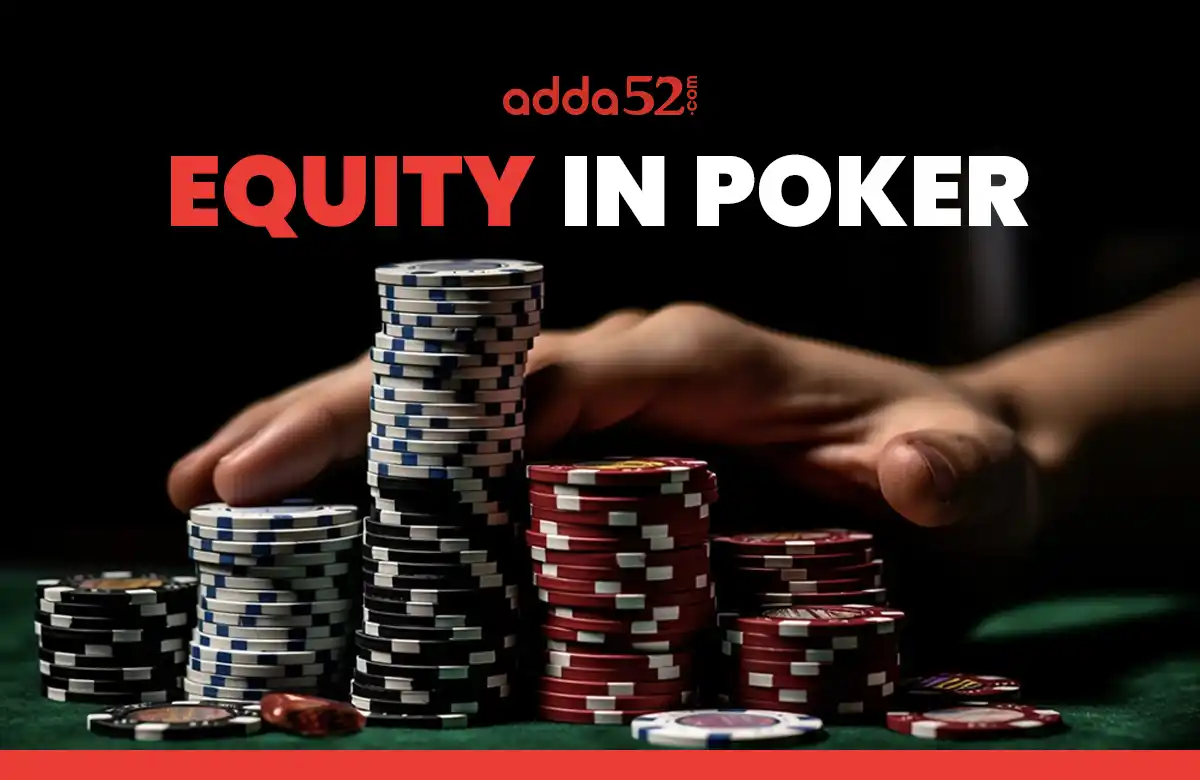
Introduction
Poker is a game of decisions, and probabilities and risks influence every decision at the table. One of the most critical concepts in Poker strategy is Poker equity—the mathematical expectation of winning the pot based on your hand's strength at any given time.
In this guide, we will explore how to calculate equity in Poker and how it can be used to enhance your game.
What is Poker Equity?
Poker equity is your share of the pot based on the probability of winning the hand. It represents your expected value in the pot if the hand were played out multiple times.
For example:
- You and your opponent have ₹1,000 each in the pot.
- If your hand has 75% equity, you are statistically expected to win ₹750 from the pot in the long run.
Equity doesn’t guarantee to win a specific hand but reflects your expected outcome over many similar situations.
Why is Poker Equity Important?
Understanding poker hand equity enables you to:
- Make Profitable Decisions: Compare your equity to the pot odds to determine whether to call, fold, or raise.
- Execute Smart Bluffs: Combine your equity with fold equity (the chance of your opponent folding) to maximize your gains.
- Minimize Losses: Recognize when your equity is too low to justify continuing in hand.
How to Calculate Poker Equity
Different methods to calculate equity exist, from quick estimations to detailed analyses using poker tools.
1. Estimating Equity with Outs
An out is a card that improves your hand to a probable winner. To estimate your equity quickly:
- Rule of 4 and 2:
Multiply the number of outs by 4 (on the flop) or by 2 (on the turn) to get your approximate equity.
Example:
You have A♠K♠, and the flop shows Q♠7♦3♠. You need one more spade for a flush.
Outs: There are 9 spades left in the deck.
On the flop: 9 × 4 = 36% equity. On the turn: 9 × 2 = 18% equity.
2. Using Software Tools
Poker equity calculators let you input your hand, opponent ranges, and board cards to calculate precise equity percentages.
3. Memorizing Common Matchups
Some equity situations arise frequently in Poker. Memorizing these can save time:
- Overpair (KK) vs. two undercards (e.g., J♦10♦): ~80%-20%.
- Flush draw (e.g., 8♥7♥) vs. top pair (e.g., Q♠K♦): ~35%-65%.
Using Poker Equity in Real Money Games
Let’s apply Poker hand equity to real-money games:
1. Comparing Equity with Pot Odds
Pot odds are the pot size ratio to the cost of calling. If your equity exceeds the pot odds, it’s profitable to continue.
Example:- Pot size: ₹1,000.
- The opponent bets ₹250.
- Total pot: ₹1,250 (₹1,000 + ₹250).
- Cost to call: ₹250.
- Pot odds: ₹1,250/₹250 = 5:1 or 20%.
If your equity is above 20%, calling is the correct move. Suppose you have a flush draw (9 outs). Your equity is 9 × 4 = 36%, making this a profitable call.
2. Semi-Bluffing with Equity
A semi-bluff involves betting with a drawing hand that has good equity. Even if your opponent calls, you still have chances to improve and win the pot.
Example:You have 10♦J♦, and the board shows Q♠8♦5♥.
- You need a 9 or a diamond to improve your hand (13 outs).
- Your equity is 13 × 4 = 52%.
You bet ₹500 into a ₹1,000 pot, and your opponent folds 40% of the time. Your bet is profitable due to your combined fold equity and actual equity.
3. Equity in Multiway Pots
Your equity decreases in pots with multiple players as more opponents contest the pot.
Example:
You hold A♦K♦, and the pot is ₹5,000. You are up against two opponents:
- Opponent 1 has 7♥7♣.
- Opponent 2 has Q♠J♠.
Using an equity calculator, you find:
- Your equity: 35%.
- Opponent 1’s equity: 40%.
- Opponent 2’s equity: 25%.
Your share of the pot is 35% × ₹5,000 = ₹1,750, meaning you should proceed cautiously unless the pot odds justify your involvement.
Mistakes to Avoid with Poker Equity
Understanding equity in Poker is crucial for making informed decisions during a game. However, even experienced players can make mistakes in assessing or applying equity concepts. Here are some common pitfalls and how to avoid them:
1. Overestimating Your Hand’s Equity
Mistake: Believing your hand is stronger than it is, especially with draws or marginal holdings.
Example: Assuming a flush draw has a guaranteed 35% equity when only one card is left to come, its real equity reduces to about 20%.
Solution: When calculating your equity, always account for the number of outs, the stage of the hand (turn or river), and the happenings on the board.
2. Ignoring Opponent’s Range
Mistake: Focusing solely on your hand’s strength without considering your opponent’s likely range.
Example: Betting aggressively with a top pair against a tight opponent who only continues with stronger hands.
Solution: Estimate your opponent’s range and adjust your play based on how your equity performs against that range.
3. Misapplying Pot Odds and Implied Odds
Mistake: Calling when the pot odds don’t justify it, or assuming implied odds will always make up for the gap.
Example: Calling a large bet with a gutshot straight draw without sufficient pot odds, hoping to win more on later streets.
Solution: Calculate your pot odds accurately and consider your opponent’s likelihood of paying off big bets if you hit your draw.
4. Forgetting Fold Equity
Mistake: Failing to consider the equity gained from forcing opponents to fold.
Example: Only shoving with strong equity hands and not considering bluffs where fold equity can make the play profitable.
Solution: Evaluate the likelihood of opponents folding and how that impacts your equity.
5. Neglecting Reverse Implied Odds
Mistake: Overvaluing hands like low flushes or straights without considering the possibility of running into stronger holdings.
Example: Drawing to a low flush when it’s clear your opponent represents a higher one.
Solution: Be cautious when playing hands that could lose big pots, especially when out of position or against skilled opponents.
6. Failing to Adjust for Multi-Way Pots
Mistake: Using heads-up equity calculations in multi-way pots, where more players reduce your equity.
Example: Overestimating the strength of a top pair hand in a pot with three other players.
Solution: Adjust your equity expectations when more players are involved, and prioritize hands that perform well in multi-way scenarios.
Frequently Asked Questions
What is the difference between equity and pot odds?
Equity is the percentage of the pot you expect to win based on your hand and the remaining cards. Pot odds represent the ratio of the current bet to the potential pot. The two work together: the call is profitable if your equity exceeds the pot odds.
How to calculate poker equity quickly?
Use the ‘Rule of 4 and 2’. Multiply your outs by 4 after the flop or 2 after the turn to estimate your chance of hitting your draw.
Does equity in Poker change during a hand?
Yes. Equity fluctuates as community cards are revealed, altering the strength of your hand and your opponent’s likely holdings. Monitoring how the board changes your equity is crucial for decision-making.
Conclusion
Poker equity is the key to profitable play. By understanding how to calculate and apply equity in different scenarios, you can make mathematically sound decisions that maximize your winnings over time. You will better appreciate Poker as a game of numbers and strategy with practice, tools, and discipline.
